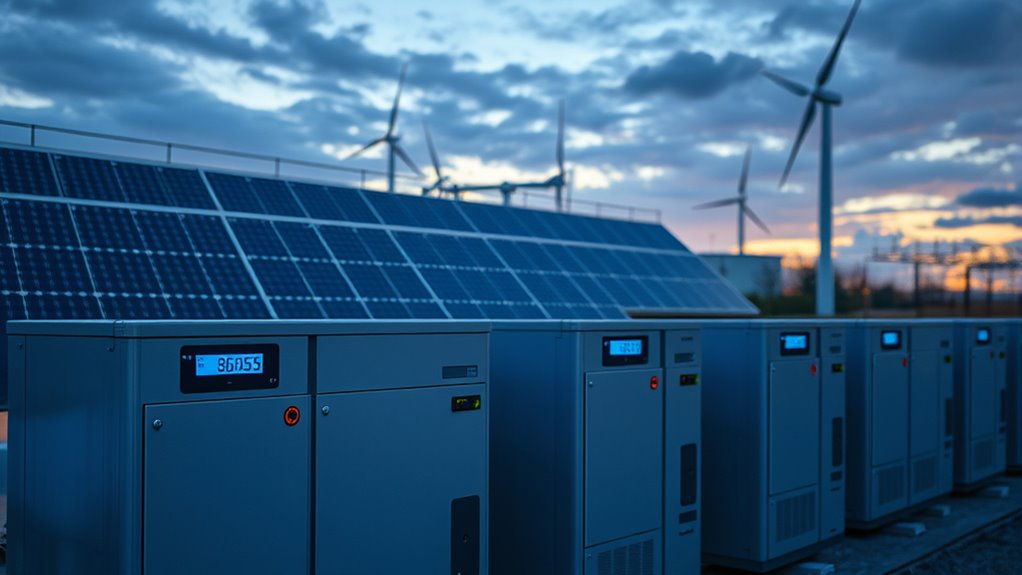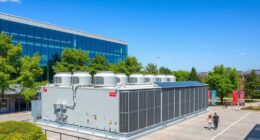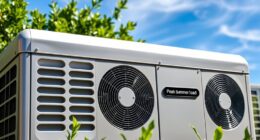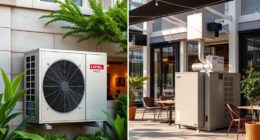Heat pumps can play a crucial role in enhancing your microgrid’s energy independence by efficiently supplying heating and integrating renewable sources. They support smart control technologies to optimize performance and adapt to environmental changes, reducing reliance on fossil fuels. Large-scale deployment boosts grid stability and demand response, aligning with policy goals like sustainability and emissions reduction. Keep exploring to see how advancements and innovations make heat pumps a key to a resilient, sustainable energy future.
Key Takeaways
- Heat pumps enable efficient, renewable-based heating within microgrids, reducing reliance on fossil fuels and enhancing energy autonomy.
- Integrating heat pumps improves demand response and grid stability through flexible operation and load management.
- Modular heat pump systems support scalable deployment across residential, commercial, and industrial microgrid applications.
- Coupling heat pumps with energy storage and smart controls optimizes renewable energy utilization and system resilience.
- Large-scale heat pump deployment accelerates decarbonization and supports microgrid integration of local renewable energy sources.
Enhancing Energy Autonomy With Renewable Heat Pumps
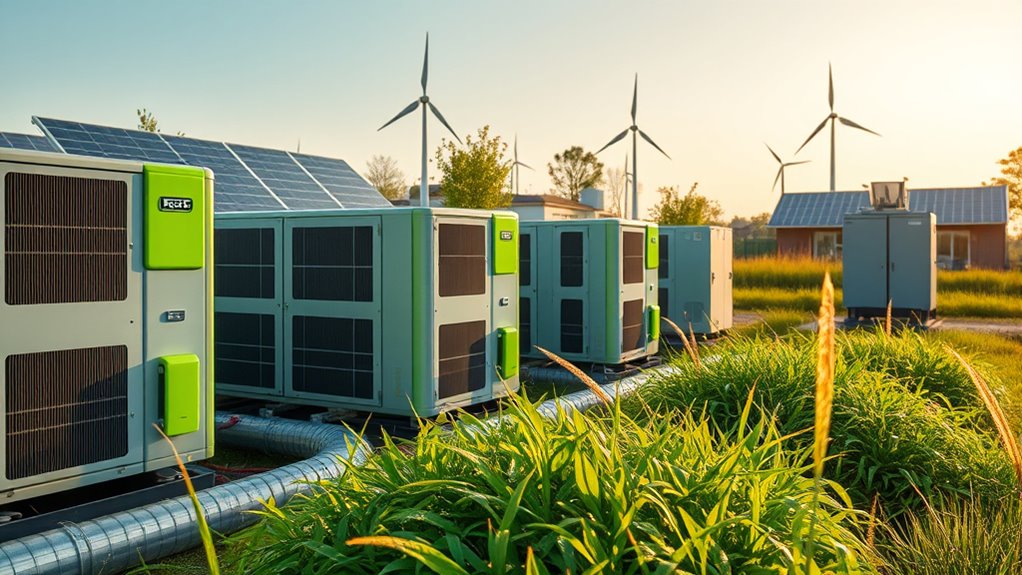
Have you considered how renewable heat pumps can boost a microgrid’s energy independence? These systems, like air-source or geothermal heat pumps, can supply up to 80% of heating needs, reducing reliance on fossil fuels. When integrated with local renewable energy sources such as solar and wind, they enhance energy autonomy by creating a self-sufficient heating solution within the microgrid. Smart grid controls, IoT, and AI optimize heat pump operation based on renewable energy availability, demand, and weather forecasts, maximizing self-sufficiency. Hybrid systems with thermal storage ensure continuous, reliable heating during low renewable generation, further increasing energy independence. Deploying renewable heat pumps supports local resilience, decreases emissions, and aligns with EU climate goals for sustainable heating through distributed energy and renewable energy integration. Energy-efficient systems play a crucial role in minimizing operational costs and environmental impact. Additionally, implementing smart grid technologies can significantly improve the coordination and efficiency of renewable heat pump systems, ensuring optimal performance and increased energy autonomy. Incorporating thermal storage solutions can also help balance supply and demand, boosting the overall reliability of the microgrid. Utilizing advanced control strategies can further optimize system operation and adapt to fluctuating renewable energy conditions, enhancing overall efficiency and independence. Moreover, a focus on personality traits such as proactive engagement and adaptability can facilitate better integration and management of these advanced energy solutions.
Integrating Smart Technologies for Optimal Performance

Integrating smart technologies like IoT and AI into microgrid heat pump systems substantially enhances their performance and responsiveness. These smart technologies enable real-time monitoring and precise regulation, optimizing energy management and system efficiency. AI-driven control systems predict environmental and usage patterns, helping you reduce energy consumption by up to 30%. IoT sensors collect detailed data on system performance, supporting predictive maintenance and extending equipment lifespan. Incorporating demand response programs allows your heat pumps to adjust operation during grid stress, improving stability and lowering peak loads. Modular control architectures facilitate scalability, making it easier to deploy heat pumps across small communities or individual homes. Additionally, implementing system integration strategies ensures seamless operation among various components, maximizing overall system effectiveness. Understanding regional resources and tools can also enhance the deployment and management of these systems. Employing smart grid technologies can further improve reliability and adaptability in diverse environments. Overall, smart technologies empower your microgrid to operate more reliably, efficiently, and adaptively, and leveraging interoperability standards helps ensure compatibility across different devices and platforms. Incorporating advanced communication protocols can boost system responsiveness and data security.
Supporting Policy Goals and Market Expansion

How do policies like the EU Green Deal and Fit for 55 accelerate the adoption of heat pumps within microgrid systems? They push for significant emission reductions, boosting policy incentives that promote low-carbon heating and renewable energy systems. In 2022, heat pump sales soared due to these incentives, fueling market expansion. Countries like the Netherlands and Sweden offer subsidies, encouraging market demand and urban development. Pairing heat pumps with microgrid integration enhances energy efficiency, supports demand response, and advances renewable energy use. The table below highlights key policy impacts:
| Policy Focus | Incentives & Support | Market Outcomes |
|---|---|---|
| Policy incentives | Subsidies, rebates | Increased heat pump adoption |
| Market expansion | Urban development programs | Broader market demand |
| Microgrid integration | Renewable energy tie-ins | Enhanced energy resilience |
| Demand response | Smart controls and AI | Improved energy efficiency |
Additionally, integrating innovative technologies such as advanced control systems can further optimize the performance of heat pumps in microgrids. Incorporating policy-driven strategies accelerates market adoption and supports the transition to sustainable energy systems. Recognizing the importance of investment in infrastructure can further facilitate widespread deployment and integration of heat pumps in various settings. A comprehensive understanding of Cultural Intelligence can also be valuable for international collaborations and navigating diverse regulatory environments. Moreover, fostering public awareness about the benefits of heat pumps can help overcome adoption barriers and promote consumer acceptance.
Advancing Innovative Heating Technologies

Advancing innovative heating technologies is essential for transforming microgrid systems into more sustainable and efficient energy networks. Here are four key developments:
- High-efficiency heat pumps optimize thermal energy use, boosting energy efficiency and reducing costs. Incorporating advanced compressor technologies and eco-friendly refrigerants further enhances performance and reduces environmental impact.
- Modular design allows easy integration into small communities and individual buildings, supporting flexible microgrid configurations.
- Smart control systems adapt operations based on environmental conditions and usage patterns, maximizing energy savings. These systems leverage AI-driven automation to optimize performance dynamically.
- Coupling heat pumps with renewable sources like solar and wind enhances renewable energy integration and promotes decarbonization. Improved energy efficiency ratings, such as HSPF and SEER, also play a crucial role in maximizing system benefits.
– Implementing budgeting tips such as automating savings contributions can further support funding for these advanced systems.
These innovations enable microgrid systems to become more resilient, environmentally friendly, and capable of delivering reliable heating while minimizing reliance on fossil fuels. The future of sustainable energy hinges on advancing these technologies.
Scaling Up for Future Energy System Integration
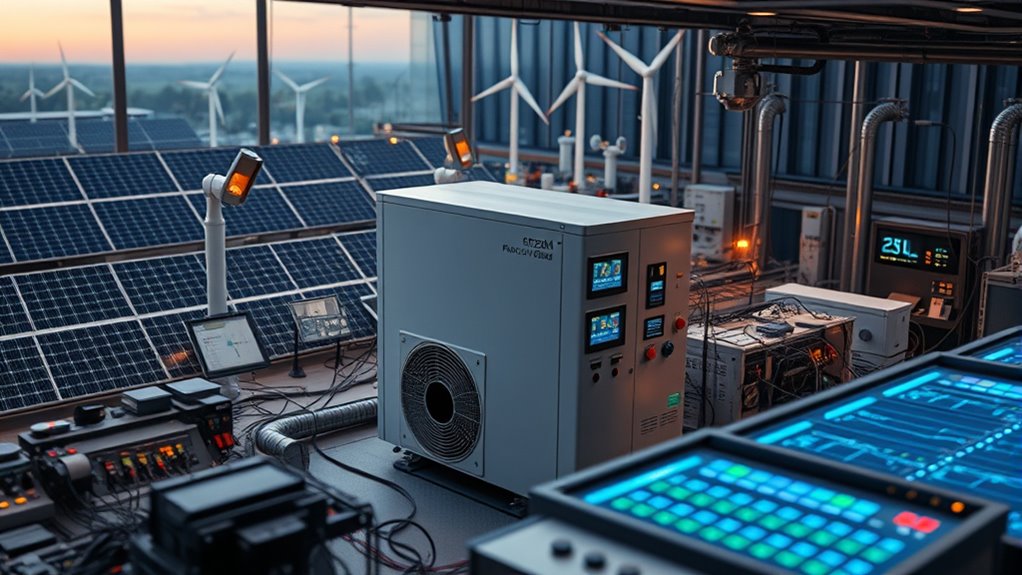
Scaling up heat pump deployment within microgrid systems is crucial for maximizing energy efficiency and supporting the shift to a cleaner energy future. Larger-scale integration of heat pump systems enhances demand response and grid balancing, making it easier to match energy supply with demand. Smart microgrid controls and IoT enable optimized operation aligned with renewable energy generation and dynamic tariffs. Modular solutions allow for incremental system scaling, accommodating diverse applications from residential to industrial sectors. Expanding heat pump systems reduces reliance on fossil fuels, advancing decarbonization goals across communities. As costs for heat pump technology and microgrid components decrease—projected at up to 20% by 2030—wider adoption becomes feasible. The integration of mind-body connection techniques from somatic therapy can also improve stakeholder wellbeing during transitions. Additionally, ongoing advancements in efficiency ratings are key to ensuring optimal performance and energy savings. The development of refrigerants with lower environmental impact further supports sustainable development goals. Incorporating renewable energy storage solutions can help mitigate issues related to intermittency and ensure consistent operation. Understanding the greenhouse gas emissions impact of these systems further supports sustainable development goals. This system scaling is essential for a resilient, sustainable energy transition and robust microgrid integration.
Frequently Asked Questions
Why Are Heat Pumps Not the Future?
You’re wondering why heat pumps might not be the future. Despite their efficiency, they face hurdles like high upfront costs and existing infrastructure that favors fossil fuels. During peak demand, they can strain the grid and become less reliable in cold climates. Policy gaps and market barriers also slow adoption, making it tough for heat pumps to fully replace traditional heating systems in the near future.
Why Don’t Contractors Like Heat Pumps?
Imagine trying to switch to a new tool in your toolbox and feeling unsure if it’ll work as well as your familiar wrench. That’s how contractors feel about heat pumps. Many hesitate because they’re unfamiliar, worry about higher costs, or doubt their performance in cold climates. Without proper training or incentives, they see these systems as risky, like trying a new gear without knowing if it’ll turn smoothly.
What Is the Main Disadvantage of a Heat Pump?
The main disadvantage of a heat pump is its reduced efficiency in very cold climates. When outdoor temperatures drop, your heat pump’s COP declines, meaning it uses more energy to provide the same amount of heat. You might need supplemental heating sources, which can increase operational costs. Additionally, cold weather can extend warm-up times and make it harder for the system to quickly meet peak heating demands.
What Is the Carbon Footprint of a Heat Pump?
You might think heat pumps are eco-friendly, but their carbon footprint depends on your electricity source. If you use renewable energy, emissions are nearly zero—sweet, right? But if powered by fossil fuels, they still cut emissions compared to traditional systems, often by 60-70%. So, while they’re greener, their true impact hinges on your grid’s clean energy share, making them a smarter choice in greener regions.
Conclusion
As you explore the future of energy, imagine neighborhoods seamlessly powered by renewable heat pumps, their quiet efficiency blending into daily life. Smart technologies connect these systems, optimizing performance effortlessly. Policies and markets align, opening new opportunities while innovative heating solutions push boundaries. Together, these advancements create a future where your home becomes part of a larger, sustainable energy network—an interconnected system that’s not just possible, but inevitable, shaping a cleaner, smarter tomorrow for everyone.
